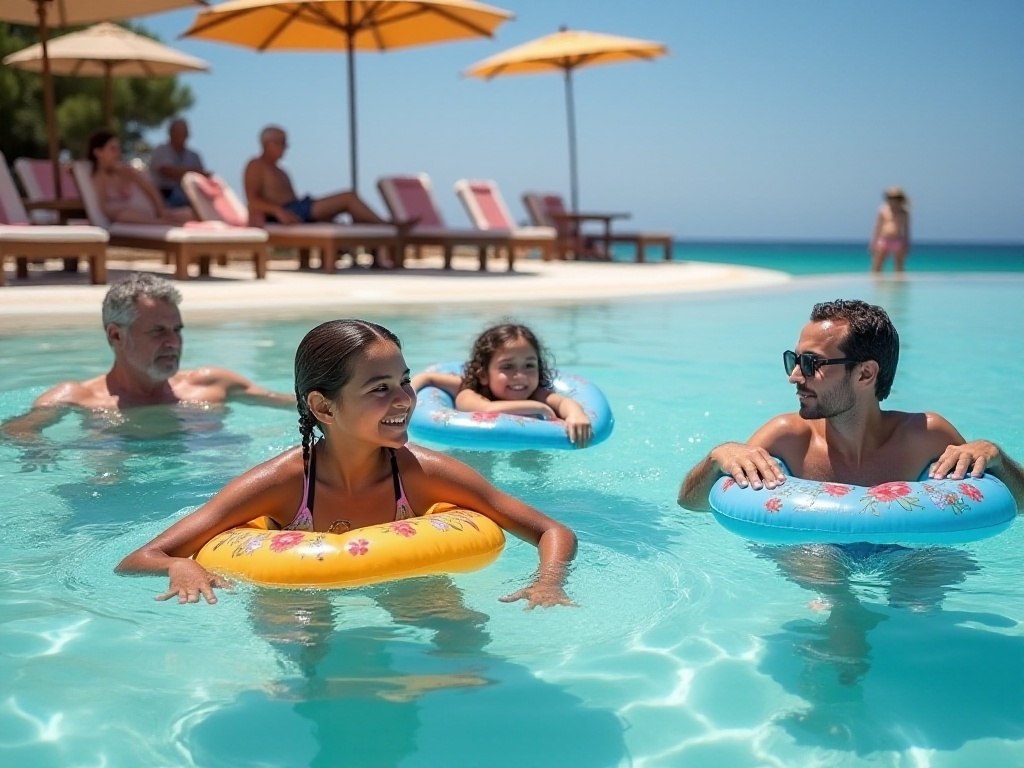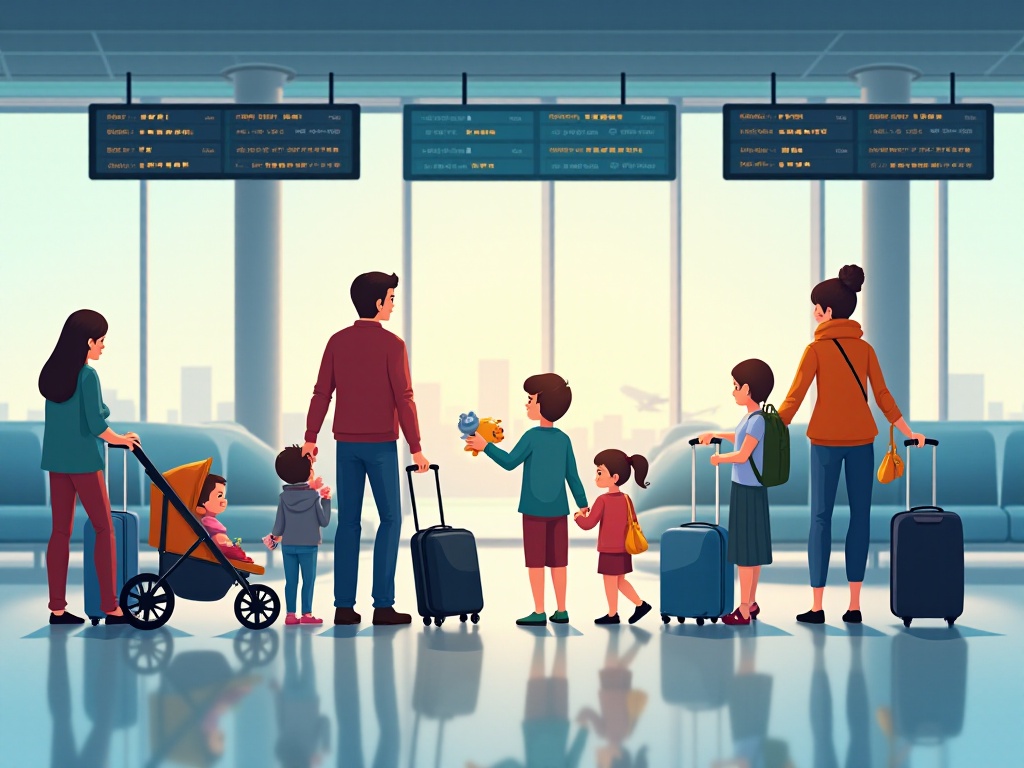Introduction
Hello everyone, I'm Lao Zhu. Today I want to share a special topic with you. The other day, a reader asked me: "Lao Zhu, I have three children - one is 14, one is 8, and the youngest is 2 years old. I want to take them on a trip together, but it seems really difficult to arrange. Do you have any suggestions?" This question is definitely worth exploring in depth.
To be honest, traveling with just one child is already anxiety-inducing, let alone three children at different developmental stages. Children at each age have their own unique needs and interests. Meeting everyone's expectations in one trip is definitely a significant challenge. However, based on my years of experience traveling with children and discussions with many parents, I've found that taking three children on a trip can become an enjoyable family experience if you master the right methods and techniques.
For Infants and Toddlers
When it comes to traveling with a 2-year-old, health and safety are always the primary concerns. Children at this age don't have fully developed immune systems, and environmental changes can easily affect their physical condition.
Last winter, my friend's experience of taking their 3-year-old daughter Xiao Mei to Japan taught me a profound lesson. Before departure, they thought their child was generally healthy and didn't do a health check. But by the third day in Japan, Xiao Mei developed severe otitis media due to the changes in environment and temperature differences. Finding a hospital in an unfamiliar place with a sick child, facing language barriers and communication difficulties - that kind of anxiety is truly overwhelming. Therefore, I strongly recommend getting a comprehensive health check before any trip, whether domestic or international.
Specifically, the health check should include the following aspects: ENT examination, as air pressure changes during flights can cause ear discomfort; routine physical examination to understand the child's basic health condition; necessary vaccinations, especially when traveling to certain regions that might require additional vaccine protection.
Additionally, an infant's sleep schedule is an absolute priority that cannot be ignored. Many parents think: "Since we're on vacation, being flexible with sleep times shouldn't matter." This thinking is actually very dangerous. I've seen too many cases where disrupted sleep schedules ruined entire trips. A child who hasn't gotten enough rest will not only be irritable but will also affect the mood of other family members.
I recommend establishing a relatively fixed schedule: don't start too early in the morning, give children enough sleep time; 9-11 AM is when children have the most energy, suitable for light sightseeing activities; prepare for lunch and nap by 11:30 AM; after 3 PM, when children are well-rested, is another golden time for activities; after 7 PM, start preparing for bedtime.
In terms of specific itinerary arrangements, pay special attention to the following points:
First is the issue of temperature changes. Young children are particularly sensitive to temperature, so bring light jackets, even in summer. Air-conditioned rooms, subway stations, and shopping malls often have temperature differences, so be ready to add or remove clothing for your child.
Second is food hygiene. Children at this age have immature digestive systems, so food hygiene is especially important. It's recommended to bring some snacks that your child is used to eating, in case suitable food can't be found outside. Also prepare enough drinking water, preferably lukewarm, as cold water can irritate the digestive system.
Then there's the diaper issue. Although 2-year-olds might be learning to use the toilet, it's still recommended to use diapers while traveling, which will be much more convenient. Prepare enough diapers, preferably 30% more than the estimated amount, just in case.
Travel equipment also needs special attention: a stroller is essential, preferably lightweight and foldable; bring a baby carrier too, useful for places where strollers aren't convenient; sunscreen is essential, choose products specifically for infants and toddlers; prepare sufficient medicines, including fever reducers, anti-inflammatory drugs, digestive medicines, etc., best to consult a pediatrician and prepare based on your child's specific conditions.

For School-Age Children
Eight-year-olds are at a particularly interesting age. Children at this age have basic self-care abilities and are full of curiosity about the world, making traveling with them quite enjoyable. However, parents shouldn't completely let go of supervision because of this.
Regarding packing, many parents think: "The child is old enough now, they should learn to pack their own luggage." This thinking isn't wrong, but the execution needs to be thoughtful. I suggest making packing an interactive process. Let the child first make their own list of everything they think they need to bring, then parents can help check and supplement. This has several benefits: it develops the child's independent thinking abilities, teaches them planning and organization, and through parental guidance, helps them understand what items are truly necessary.
Specifically for the packing list, I recommend including the following categories:
Clothing: Prepare based on the destination's weather conditions, including necessary changes of clothes and a windproof/rainproof jacket.
Learning and entertainment items: Bring a sketchbook and colored pencils for recording travel experiences and passing time while waiting; tablets are okay but set usage time limits; bring one or two favorite books.
Toiletries: Children this age have established basic hygiene habits, let them bring their own toothbrush, towel, and other items.
Snacks and water bottle: Let children participate in choosing snacks, but control the quantity and choose foods that are easy to carry and won't make a mess.
During the trip, 8-year-olds can already handle some manageable tasks. For example, they can be responsible for their own backpack, record daily expenses, or help watch younger siblings. This not only cultivates responsibility but also lets them feel they're important family members.
When choosing attractions, pay special attention to combining fun and education. For example, at museums, prepare a small notebook for the child to record their favorite exhibits; when visiting nature areas, play games involving plant observation and animal identification; at historical sites, tell interesting historical stories.
Additionally, 8-year-olds have begun developing social needs. If possible, let them play with peers their age. But pay attention to safety issues and don't let children leave your line of sight.

For Teenagers
Talking about 14-year-olds, this is indeed the most challenging age group. They're at a crucial period of seeking self-identity and establishing independent personalities, and may have complex feelings about family travel. On one hand, they hope to spend quality time with family; on the other hand, they worry that playing with younger children might seem childish and affect their image among peers.
The key to handling this situation is fully respecting teenagers' thoughts and needs. The Wang family I know does this particularly well. They hold a family meeting before trips, letting their 14-year-old son participate fully in trip planning. They not only let him be responsible for planning one day's itinerary but also involve him in setting the entire trip's budget. This makes the child feel respected and trusted, while also developing their decision-making abilities and sense of responsibility.
For specific arrangements, pay attention to these points:
First is time allocation. Don't force teenagers to stay with younger siblings all day. Arrange some activities suitable for older children, like letting them ride thrilling rides at theme parks instead of being forced to accompany younger children on carousels.
Second is social needs. Today's teenagers can't leave social media, so rather than prohibiting phone use, set reasonable usage rules. For example, they can post on social media when checking in at attractions or keep in touch with friends during rest times.
Then there's the issue of personal space. When booking rooms, if conditions allow, try to arrange independent space for teenagers. This way they can have their private time and won't feel too restricted.
In activity selection, fully consider teenagers' interests. For example:
If they like photography, let them be responsible for family travel photos, which both cultivates their interest and lets them feel their value.
If they're particularly interested in certain fields, like history or technology, specifically arrange related visits.
If there are places they particularly want to visit, try to fulfill their wishes within budget and time constraints.

Practical Preparation
For specific preparations, many details need special attention. Let me expand on the most important points:
Documentation is crucial. Many attractions now require real-name registration, so ID cards are essential. For children without ID cards, arrange temporary ones in advance. For international travel, passports must be valid for at least 6 months, and note that some countries require visas. Check all documents in advance, make copies for backup, and save electronic versions on your phone.
Insurance is often overlooked. Especially for domestic travel, many think it's unnecessary. But I must emphasize that insurance is essential when traveling with children. First is accident medical insurance, as children are naturally active and prone to bumps and scrapes; second is trip change insurance in case the itinerary needs last-minute adjustments; and property insurance to protect valuable items carried.
Accommodation choice is also crucial. I especially recommend apartment-style accommodations with kitchens for many reasons: first, you can cook your own meals, especially important for 2-year-olds who often can't eat outside food; second, there's more space than hotel rooms, giving children room to move; third, having a washing machine allows immediate handling of children's dirty clothes; finally, cost-wise, apartments are more economical than hotels for longer stays.
When choosing accommodation, pay special attention to these points:
Location should be convenient, preferably near subway or bus stations for easy travel.
There should be supermarkets and restaurants nearby for daily supplies and emergency meals.
Check if there's an elevator - without one, high floors are very inconvenient.
Room safety facilities should be complete, including window guards, smoke alarms, etc.

Helpful Tips
During actual travel, I've summarized some particularly useful tips to make the whole process easier:
Preventing children from getting lost is paramount. Besides preparing wristbands or cards with parents' phone numbers for each child, also take these measures: dress children in bright colors for easy identification in crowds; teach children what to do if separated, like waiting in place or seeking help at service desks; use smartwatch or phone positioning functions to track children's locations in real-time.
Luggage management is also a big issue. The color coding system is indeed useful, but you can go further: label each suitcase or storage bag with specific contents; pack daily necessities separately to avoid rummaging through everything; prepare an "emergency bag" with common medicines, band-aids, wet wipes, etc., to carry with you.
Food issues also need special attention: research restaurants at your destination in advance to see if there are suitable choices for the whole family; bring some dry food and snacks in case suitable restaurants can't be found; bring a portable kettle for milk or instant foods anytime; prepare some nutrition bars or dried fruits for emergency energy supplements.
Transportation arrangements need careful consideration: for self-driving trips, prepare child safety seats; for flights, understand airline regulations for child passengers in advance; for trains, preferably choose compartment seats to avoid disturbing other passengers.
Time management is also important: don't pack each day's schedule too full, leave enough rest and flexible time; arrange activities according to different age groups' schedules; prepare some portable small games or toys for use during wait times.

Final Thoughts
Traveling with three children of different ages indeed requires more thought and energy. However, with adequate preparation and reasonable planning, such travel won't become a burden but rather the family's most precious memories.
Seeing children grow during travel, experiencing intimate family interactions - these are gains that money can't measure. Moreover, through travel, children can broaden their horizons, gain knowledge, learn to care for others, develop independence - these are all very valuable life experiences.
Remember, the meaning of travel isn't about how many places you've been or how many attractions you've seen, but about the wonderful time spent together as a family. So don't pursue perfection too much, relax appropriately, let the journey flow naturally - this is how to truly enjoy family travel.
If you also have similar family travel questions, welcome to leave comments - your question might be the topic of the next issue. Let's share and grow together.









